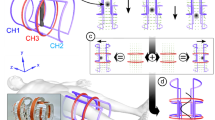Abstract
Purpose
Magnetic particle imaging (MPI) is a novel tomographic radiation-free imaging technique that combines high spatial resolution and real-time capabilities, making it a promising tool to guide vascular interventions. Immediate availability of 3D image data is a major advantage over the presently used digital subtraction angiography (DSA), but new methods for real-time image analysis and visualization are also required to take full advantage of the MPI properties. This laboratory study illustrates respective techniques by means of three different patient-specific 3D vascular flow models.
Material and Methods
The selected models corresponded to typical anatomical intervention sites. Routine patient cases and image data were selected, relevant vascular territories segmented, 3D models generated and then 3D-printed. Printed models were used to perform case-specific MPI imaging. The resulting MPI images, direct volume rendering (DVR)-based fast 3D visualization options, and their suitability to advance vascular interventions were evaluated and compared to conventional DSA.
Results
The experiments illustrated the feasibility and potential to enhance image interpretation during interventions by using MPI real-time volumetric imaging and problem-tailored DVR-based fast (approximately 30 frames/s) 3D visualization options. These options included automated viewpoint selection and cutaway views. The image enhancement potential is especially relevant for complex geometries (e.g., in the presence of superposed vessels).
Conclusion
The unique features of the as-yet preclinical imaging modality MPI render it promising for guidance of vascular interventions. Advanced fast DVR could help to fulfill this promise by intuitive visualization of the 3D intervention scene in real time.






Similar content being viewed by others
References
Gleich B, Weizenecker J. Tomographic imaging using the nonlinear response of magnetic particles. Nature. 2005;435:1214–7.
Borgert J, Schmidt JD, Schmale I, Rahmer J, Bontus C, Gleich B, et al. Fundamentals and applications of magnetic particle imaging. J Cardiovasc Comput Tomogr. 2012;6:149–53.
Weizenecker J, Gleich B, Rahmer J, Dahnke H, Borgert J. Three-dimensional real-time in vivo magnetic particle imaging. Phys Med Biol. 2009;54:L1–10.
Haegele J, Panagiotopoulos N, Cremers S, Rahmer J, Franke J, Duschka RL, et al. Magnetic particle imaging: a Resovist based marking technology for guide wires and catheters for vascular interventions. IEEE Trans Med Imaging. 2016;35(10):2312–8.
Rahmer J, Halkola A, Gleich B, Schmale I, Borgert J. First experimental evidence of the feasibility of multi-color magnetic particle imaging. Phys Med Biol. 2015;60:1775–91.
Rahmer J, Wirtz D, Bontus C, Borgert J, Gleich B. Interactive magnetic catheter steering with 3-D real-time feedback using multi-color magnetic particle imaging. IEEE Trans Med Imaging. 2017;36(7):1449–56.
Stangenberg L, Shuja F, Carelsen B, Elenbaas T, Wyers MC, Schermerhorn ML. A novel tool for three-dimensional roadmapping reduces radiation exposure and contrast agent dose in complex endovascular interventions. J Vasc Surg. 2015;62(2):448–55.
Bargellini I, Turini F, Bozzi E. Image fusion of preprocedural CTA with real-time fluoroscopy to guide proper hepatic artery catheterization during transarterial chemoembolization of hepatocellular carcinoma: a feasibility study. Cardiovasc Interv Radiol. 2013;36:526–30.
Van den Berg JC. Update on new tools for three-dimensional navigation in endovascular procedures. Aorta (Stamford). 2014;2(6):279–85.
Zhang Q, Sun Q, Zhang Y, Zhanf H, Shan T, Han J, et al. Three-dimensional image fusion of CTA and angiography for real-time guidance during neurointerventional procedures. J Neurointerv Surg. 2017;9:302–6.
Herz S, Vogel P, Dietrich P, Kampf T, Rückert MA, Kickuth R, et al. Magnetic particle imaging guided real-time percutaneous transluminal angioplasty in a phantom model. Cardiovasc Interv Radiol. 2018;41:1100–5.
Hossmann KA, Heiss WD. Ch.1. In: Brainin M, Heiss WD, editors. Textbook of stroke medicine. Cambridge University Press: Cambridge; 2009. p. 1–27.
Clark TW. Complications of hepatic chemoembolization. Semin Interv Radiol. 2006;23:119–25.
Fedorov A, Beichel R, Kalpathy-Cramer J, Finet J, Fillion-Robin JC, Pujol S, et al. 3D Slicer as an image computing platform for the quantitative imaging network. Magn Reson Imaging. 2012;30:1323–41.
Zarrinkoob L, Ambarki K, Wåhlin A, Birgander R, Eklund A, Malm J. Blood flow distribution in cerebral arteries. J Cereb Blood Flow Metab. 2015;35(4):648–54.
Carlisle KM, Halliwell M, Read AE, Wells PN. Estimation of total hepatic blood flow by duplex ultrasound. Gut. 1992;33(1):92–7.
Weber A, Werner F, Weizenecker J, Buzug TM, Knopp T. Artifact free reconstruction with the system matrix approach by overscanning the field-free-point trajectory in magnetic particle imaging. Phys Med Biol. 2016;61:475–87.
Knopp T, Hofmann M. Online reconstruction of 3D magnetic particle imaging data. Phys Med Biol. 2016;61(11):N257–67.
Fishman EK, Ney DR, Heath DG, Corl FM, Horton KM, Johnson PT. Volume rendering versus maximum intensity projection in CT angiography: what works best, when, and why. Radiographics. 2006;26(3):905–22.
Rahmer J, Antonelli A, Sfara C, Tiemann B, Gleich B, Magnani M, et al. Nanoparticle encapsulation in red blood cells enables blood-pool magnetic particle imaging hours after injection. Phys Med Biol. 2013;58:3965–77.
Kaul M, Mummert T, Jung C, Salamon J, Khandhar A, Ferguson M, et al. In vitro and in vivo comparison of a tailored magnetic particle imaging blood pool tracer with Resovist. Phys Med Biol. 2017;62:3454–69.
Szwargulski P, Möddel M, Gdaniec N, Knopp T. Efficient joint image reconstruction of multi-patch data reusing a single system matrix in magnetic particle imaging. IEEE Trans Med Imaging. 2019;38:932–44.
Griese F, Knopp T, Werner R, Schlaefer A, Möddel M. Submillimeter-accurate marker localization within low gradient magnetic particle imaging tomograms. Int J Mag Part Imaging. 2017;3(1):1703011.
Acknowledgements
We acknowledge funding by the German Research Foundation (Grant Number KN 1108/2-1) and the Federal Ministry of Education and Research (Grant Numbers 05M16GKA, 13XP5060B).
Author information
Authors and Affiliations
Corresponding author
Ethics declarations
Conflict of interest
René Werner receives a research grant from Siemens Healthcare GmbH (not related to present study). Tobias Knopp receives a research grant from Philips GmbH Innovative Technologies (not related to the present study).
Additional information
Publisher's Note
Springer Nature remains neutral with regard to jurisdictional claims in published maps and institutional affiliations.
Electronic supplementary material
Below is the link to the electronic supplementary material.
Rights and permissions
About this article
Cite this article
Weller, D., Salamon, J.M., Frölich, A. et al. Combining Direct 3D Volume Rendering and Magnetic Particle Imaging to Advance Radiation-Free Real-Time 3D Guidance of Vascular Interventions. Cardiovasc Intervent Radiol 43, 322–330 (2020). https://doi.org/10.1007/s00270-019-02340-4
Received:
Revised:
Accepted:
Published:
Issue Date:
DOI: https://doi.org/10.1007/s00270-019-02340-4




